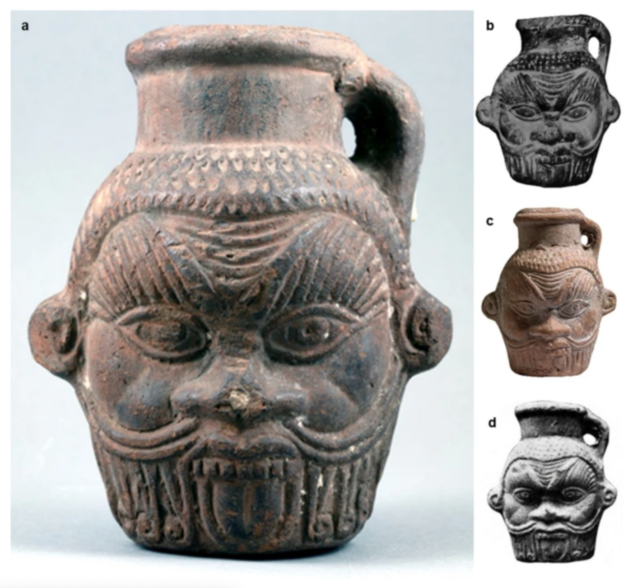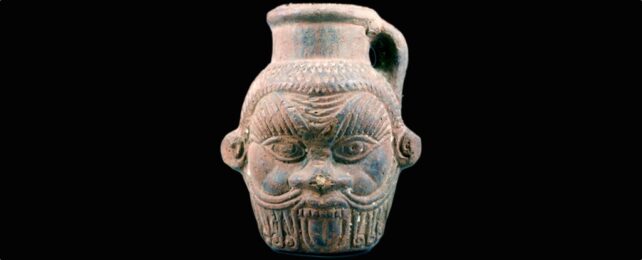A 2,200-year-old ceramic drinking vessel has confirmed what archaeologists have long suspected: some ancient Egyptians were tripping on hallucinogens.
For the first time, scientists have discovered the organic residue of psychedelic plants within an ancient Egyptian artifact, which once held a fruity, fermented sedative, sweetened with honey, tinged with possible licorice, and deliberately imbued with human fluids.
The alcoholic and hallucinogenic cocktail was probably swallowed in the name of the god Bes, whose face is featured on the outside of the vessel.
"There's no research out there that has ever found what we found in this study," says archaeologist Davide Tanasi from the University of South Florida.
Bes was an Egyptian deity of music, merriment, and childbirth, sometimes known as the "giver of dreams/oracles". Scientists have unearthed more than 380 Bes vessels from the ancient Egyptian civilization, and yet it's a mystery what these drinking containers once held, and why.
"For a very long time now, Egyptologists have been speculating what mugs with the head of Bes could have been used for, and for what kind of beverage, like sacred water, milk, wine, or beer," explains Branko van Oppen, curator of Greek and Roman art at the Tampa Museum of Art.
"Experts did not know if these mugs were used in daily life, for religious purposes, or in magic rituals."

The container found with traces of hallucinogenic plants may not be representative of all Bes vessels, but it is certainly enlightening. It was donated to the Tampa Museum of Art in 1984, and was recently studied by a team of scientists from the US and Italy.
The jug contains evidence of three plants with known hallucinogenic properties.
The first is a blue water lily (Nymphaea nouchali) – a psychoactive plant that Bes is often featured emerging from. This flower is also featured on several other Bes vessels.
The second psychoactive plant is called Syrian rue (Peganum harmala). The seeds of this plant, sometimes known as African rue, are a sedative that have hallucinogenic properties when consumed in small amounts, inducing dream-like visions very similar to what is described in ancient myths about Bes.
In one such myth, for instance, Bes stops the wrath of a bloodthirsty goddess by serving her a spiked beverage. The drink lulls her into a deep sleep.
The third plant was from the Cleome genus, which has also been found to induce hallucinations.
The Bes vessel kept at the museum in Tampa was originally found in a region of Egypt to the south of what is now Cairo, and it's tentatively dated to the second century BCE.
During this time, an Egyptian city nearby hosted so-called 'Bes chambers', in which mysterious rituals were carried out.
Several human proteins identified in the residue suggest "a deliberate addition of human fluids to the drink prepared for ritual purposes, the team writes.
"This includes fluids like breast milk, mucous fluids (oral or vaginal), and blood."
Perhaps these rituals involved drinking a sedative. The inclusion of human fluids may have helped personalize the spiritual experience.
"Egyptologists believe that people visited the so-called Bes Chambers at Saqqara when they wished to confirm a successful pregnancy because pregnancies in the ancient world were fraught with dangers," explains Van Oppen.
"So, this combination of ingredients may have been used in a dream-vision inducing magic ritual within the context of this dangerous period of childbirth."
Researchers hope that more Bes vessels are analyzed in similar ways. Only then will we understand how often hallucinogenic cocktails were consumed in ancient Egypt and why.
"With this study, we've found scientific proof that the Egyptian myths have some kind of truth and it helps us shed light on the poorly understood rituals that were likely carried out in the Bes Chambers in Saqqara, near the Great Pyramids at Giza," says Tanasi.
The study was published in Nature.
